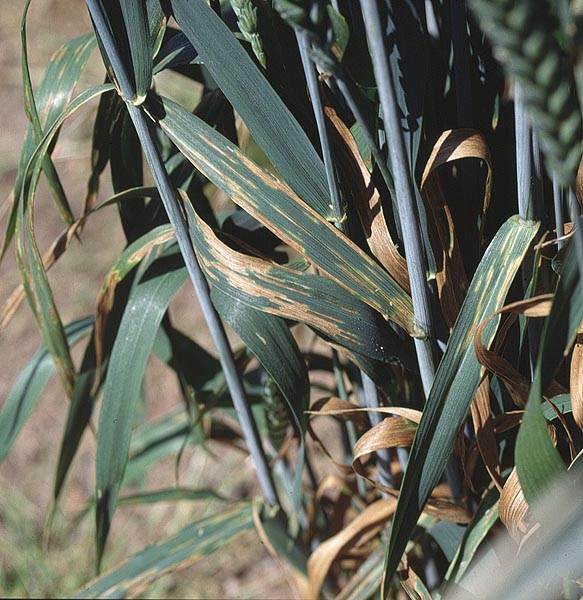
With the recent unsettled weather, spray intervals and dose rates will need to be closely monitored heading toward the impending flag leaf spray, warn technical experts from crop protection companies BASF and Syngenta.
This advice comes as part of the TON partnership, a joint campaign launched by Syngenta and BASF in the UK, to raise awareness of the potential issues of fungicide resistance in cereal crops and provide practical guidance to growers and agronomists to help manage for it.
Wheat crops
Louis Wells, agronomy manager with BASF in the north east of England, who helps to manage the BASF biodiversity and trials site at Rawcliffe Bridge Farm in Goole, Yorkshire, is seeing Septoria tritici in the base of most wheat crops in early April, so with the recent unsettled weather this is ripe to move up the crop he warns.
Whilst he is not seeing much yellow rust in early April he adds that there are still many rust susceptible varieties in the ground such as Santiago and Kielder, so they will need careful monitoring.”
“With this in mind and the unsettled conditions forecast, managing the interval between the T1, growth stage 32 and T2, growth stage 39 sprays, when the flag leaf blade should all be visible - will be critical. Timing is all about how long leaf 2 has been out – if more than 10 days then the flag leaf spray has to go on – even if not all the flag leaves are out as it will be necessary to go on again as soon as the ears are out.”
However he is keen to point out that dose rate of fungicides at T2 will be equally important to think about. “SDHI containing fungicides at T2 are essential and don’t skimp on the rate; consider the rate of the SDHI first as that will determine the rate of control. Triazole are also essential as components of the tank mix at T2 providing activity against Septoria and rusts and aiding resistance management.”
“If weather conditions mean that spraying is delayed, then dose rates should be kept up.”
Jonathan Ball of BASF suggests that where possible adding 1l/ha CTL where appropriate offers not only a more robust treatment but as a means of resistance management which is a key message of the TON campaign.
Barley
Looking at barley, Syngenta field technical manager Iain Hamilton says there was plenty of disease inoculum in early spring, so it is important not to let this get out of hand.
Varieties also differ in their disease susceptibilities, he says, for example with some winter barleys being more susceptible to Rhynchosporium and others to brown rust. So a “one size fits all” approach to fungicide programmes shouldn’t be relied on, he adds.
“As well as achieving effective disease control, it’s also important to protect the fungicides we have available in barley from a resistance management perspective,” says Mr Hamilton.
“Using strategies and spray timings to keep barley crops in a protectant situation is useful in this regard because it gives you a wider range of fungicides to choose from – both protectant and curative.”
“What’s also useful is that mixing fungicides with different modes of action, such as SDHI + triazole + partner, not only aids resistance management, but has also been shown to increase barley yield over a two-way tank mix. So there can be income benefits from using multiple modes of action as well”.
Key messages from the TON launch for protecting fungicide performance on-farm for both wheat and barley:
• A robust programme early in the season is important to avoid chasing disease
• Multiple modes of action at each timing help to mitigate the effect or delay the onset of resistance.
• Always aim to apply fungicides preventively to get the best levels of control.
• Triazoles are important to protect SDHIs, but SDHIs also protect triazoles.
• Multi-site fungicides are important to protect triazoles as well as SDHIs.
• Driving for yield is the way to ensure good margins, even with low commodity prices; in wheat the long term average fungicide response > 2t/ha (+£250/ha).
Don’t let resistance affect profits
According to agricultural economist Graham Redman of The Andersons Centre, if resistance reduces the effectiveness of inputs, it could have a substantial impact on the economic performance of cereal crops.
He added that fungicides still provide a significant return on investment, so it is vital that growers and their agronomists sit down together and take into account the agronomic and financial impact of the fungicides programmes planned for the spring.
Pointing to farm modelling for feed wheat for 2015, he says that a drop in wheat yield, for example due to fungicide resistance, would push up the cost of production per tonne. Alternatively, he says resistance could result in having to spend more just to maintain the same output.
“New approaches will be needed if resistance to fungicides increases,” points out Mr Redman. “So while we’ve got good fungicides, let’s look after them so they work for years to come. Output has to be maintained.”
